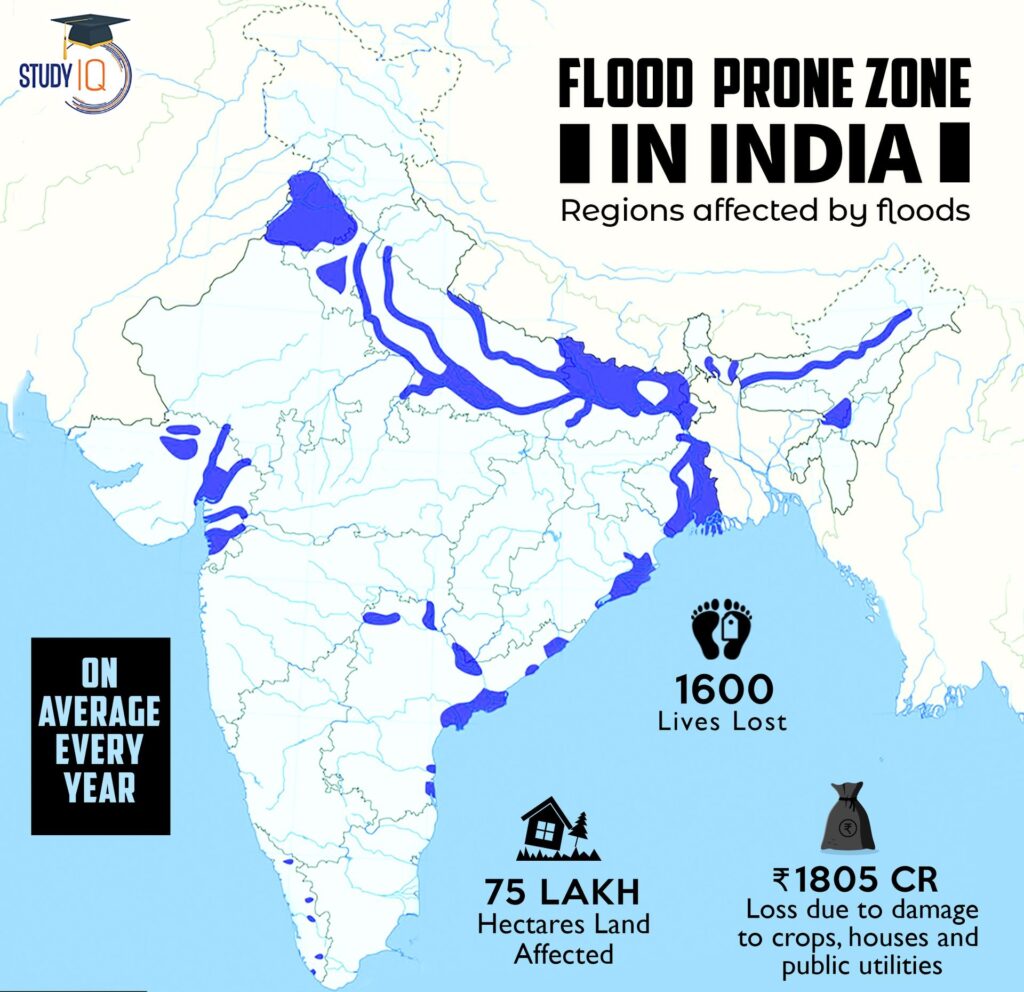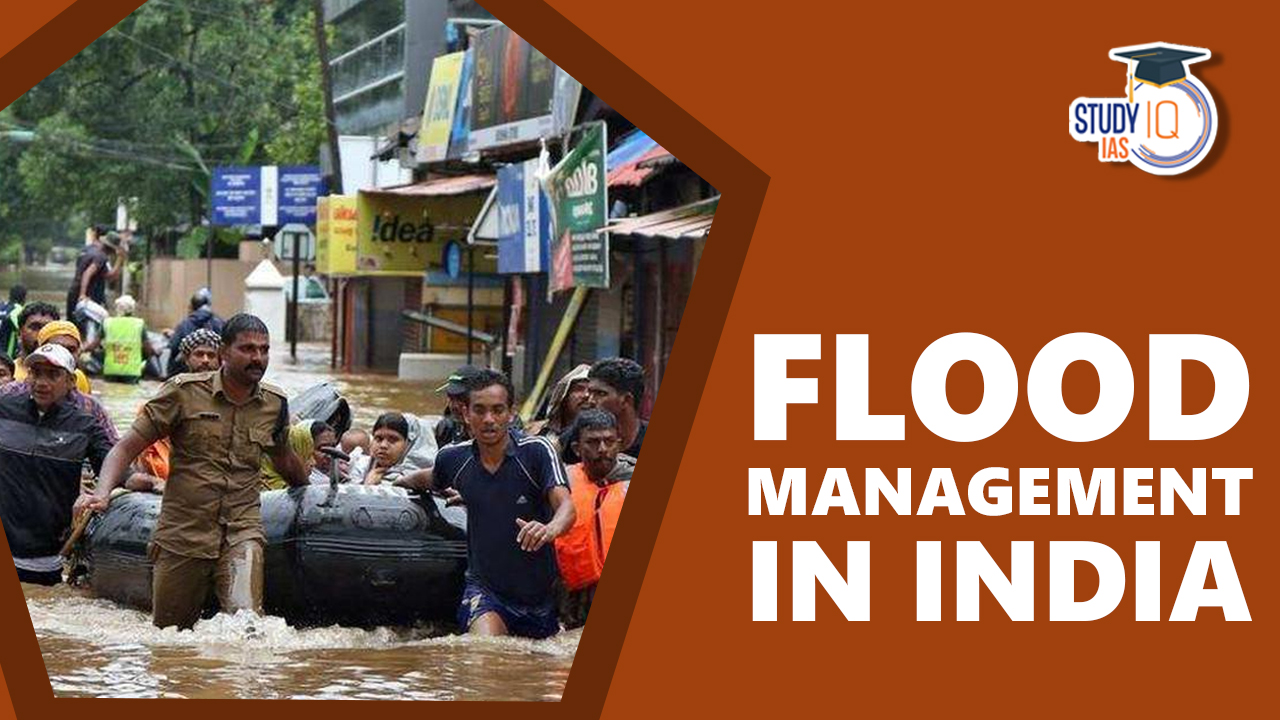Table of Contents
Flood Management in India
Flood Management in India is a necessity due to its unique geo-climatic condition backed with socio-economic vulnerability makes India a flood prone nation. Of 3290 lakh hectares of India’s Geographical area, 400 lakh hectares of area is prone to flood accounting for 12% of total land area in India. The present scenario is that the flood is occurring even in those area which earlies was not flood prone. Flood prone region in India can be classified into four parts as:
Brahmaputra River Region
This area, which includes the Northeastern states and northern West Bengal, is made up of the rivers Brahmaputra and Barak and their tributaries. This area has severe and regular floods.
Ganga River Region
The Ganga River and its tributaries make up this area. Uttarakhand, Uttar Pradesh, Jharkand, Bihar, the southern and central portions of West Bengal, Punjab, portions of Haryana, Himachal Pradesh, Rajasthan, Madhya Pradesh, and Delhi are included in its scope.

North West River Region
The Indus, Sutlej, Beas, Ravi, Chenab, and Jhelum are some of the major rivers in this area. The states of Jammu & Kashmir, Punjab, and portions of Himachal Pradesh, Haryana, and Rajasthan are included in this region. This area has less of a flood problem than the Ganga and Brahmaputra river basins.
Central India and Deccan Region
Rivers like the Narmada, Tapi, Mahanadi, Godavari, Krishna, and Cauvery are significant in this area. The states of Andhra Pradesh, Karnataka, Tamil Nadu, Kerala, Orissa, Maharashtra, Gujarat, and a portion of Madhya Pradesh are included in this region. Periodically, flooding occurs in the states along the east coast’s delta and coastal regions.
Lakshadweep and the Andaman and Nicobar Islands also have peculiar qualities that cause drainage problems, flooding, and coastline erosion.
Mitigation Strategy for Flood in India
Many different strategies are used to lessen or alleviate the risks associated with flooding. They can be divided broadly into two categories: structural measures and non-structural measures.
| Structural Measures | Non-Structural Measures | |
| Concept |
|
|
| Measures |
|
|
Constitutional Provision
Contrary to irrigation, the topic of flood management is not specifically addressed in the seventh schedule. However, the two measures that are particularly stated in entry 17 of List II are drainage and embankments. Therefore, the states have the major responsibility for flood control.
Nodal Ministries
The Ministry of Home Affairs (MHA) is the main ministry for disaster management. The technical parts of flood management are handled by the Ministry of Water Resources and other departments. The management of floods involves the ministries of agriculture, civil aviation, environment and forests, health, space, earth sciences, mines, railroads, etc.
National Flood Management Commission
It was established on 1954 under which different structural and non structural methods which have been applied to various states for flood control.
National Disaster Management Authority
It is the agency in charge of establishing disaster management policies, strategies, and guidelines as well as coordinating their enforcement and execution to guarantee a prompt and efficient response to disasters. It has published instructions for managing floods. The organization in charge of providing a specialist reaction to any impending calamities in India is the National Disaster reaction Force, which is governed by the NDMA.
Central Water Commission
The CWC is the leading organization in the management of water resources, particularly floods. The CWC’s Flood control Organization is in charge of conducting techno-economic analyses of flood control projects and multifunctional initiatives with a focus on flood management. Additionally, it develops and enhances flood forecasting methods while also producing daily or weekly flood bulletins.
Brahmaputra Board
The Brahmaputra Board Act of 1980 established the Brahmaputra Board as a legal entity. It is in charge of creating and carrying out plans for the Brahmaputra valley’s water resource development, erosion control, drainage management, and flood management.
Ganga Flood Control Commission
It was established in 1972 as a division of the Ministry of Water Resources with the goal of managing floods in the states that make up the Ganga Basin.
Rashtriya Barh Aayog, 1976
To develop a scientific, comprehensive, and well-resourced flood control strategy. To control human activities, it suggested zoning and management of flood plains.
Regional task forces, 1996
It was established to assess the results of the Rashtriya Barh Aayog’s recommendations. Following the implementation of flood plain zoning, it suggested significant flood mitigation initiatives.
National Water Policy, 2002
It recommended a basin-based plan for managing and controlling flooding. The policy for reservoir regulation should prioritize flood control. A stronger focus on non-structural actions. Strict restrictions on construction and business operations in flood plains.
K. Mittal Committee, 2003
It recommended as
- Reforestation and Afforestation, catchment area care, appropriate land-use techniques, and others.
- A development of adequate hydraulic structures that could trap silt in the river itself.
- Only after thorough investigations on the behavior of the aggravating river, particularly due to sedimentation load and resulting morphological changes, should embankment along the river be constructed.
What are the issues with the flood management in India?
- Project delays related to the flood management program.
- The lack of resources, particularly in terms of central support for the states.
- In India, there are very few big dams that have preparedness strategies.
- Flood zones are still not fully assessed scientifically.
- Not many states use the state-level disaster management system. The reaction problems are made worse by the incomplete structure.
- The flood predictions are highly inaccurate. The accuracy of the weather forecasts is poor.
- Most post-disaster deliberations are not conducted, which leads to the same mistakes being repeated repeatedly.
Flood Management in India UPSC
- By locating them in flood-prone locations, the flood forecasting needs to be improved and, more significantly, decentralized.
- Flood management organizations must frequently carry out flood mapping.
- The preparation will be improved by pre- and post-monsoon inspection of structural measures.
- The development of the disaster response force’s capacity must take into account global best practices.
- Nowadays, urban flooding is a serious threat. This risk must be considered by the smart cities initiative.
- Flooding that occurs frequently has been largely brought on by the consequences of climate change. The adoption and mitigation strategies must be implemented with a sense of urgency.
- Geopolitical situations should not be a shackle for international collaboration in the sharing of hydrological data.


 How African Reserves Eliminated Rhino Po...
How African Reserves Eliminated Rhino Po...
 Why India Needs Its Own Economic Model?
Why India Needs Its Own Economic Model?
 Challenges in India’s Airline Sector: ...
Challenges in India’s Airline Sector: ...

























